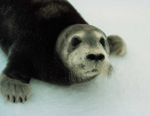Bearded Seal (Erignathus barbatus)
Status | Taxonomy | Species Description | Habitat | Distribution |
Population Trends | Threats | Conservation Efforts | Regulatory Overview |
Key Documents | More Info
Status
ESA Candidate Species - throughout its range
MMPA - Bearded seals, like all marine mammals, are protected under the MMPA.
Taxonomy
Kingdom: Animalia
Phylum: Chordata
Class: Mammalia
Order: Carnivora
Family: Phocidae
Genus: Erignathus
Species: barbatus
Species Description
Bearded seals are members of the "true seal" family, Phocidae. They have a small head, large body, and small, square foreflippers. They have a short snout with thick, long white whiskers, which gives this species their "bearded" name. Their coat is dark brown or gray with dark rings and spots.
They are the largest species of arctic seal. Bearded seals grow to lengths of about 7-8 ft (2.0-2.5 m) and weigh about 575-800 lbs (260-360 kg), with females being slightly larger than males. Their lifespan exceeds 25 years.
They are solitary animals and individual seals rest on single ice floes facing the water for an easy escape from predators. Bearded seals are extremely vocal and males' songs can be heard for up to 12 miles.
Little is known about the mating and breeding rituals of bearded seals. Females reach sexual maturity around 5 years and males at 6-7 years. Females give birth to a single pup while hauled out on pack-ice. Pups are usually born between mid-March and May and are weaned at about 15 days old.
Bearded seals feed on "benthic" prey such as arctic cod, shrimp, clams, crabs, and octopus. While feeding, they dive to depths usually less than 325 ft (100 m).
Habitat
Bearded seals reside in arctic waters and are commonly found with drifting sea ice. They inhabit waters less than 650 ft (200 m) deep.
Distribution
Bearded seals are found in the Northern Hemisphere with a circumpolar distribution that does not extend farther north than 80°N.
Population Trends
There is one stock of bearded seals in U.S. waters: the Alaska stock. Early estimates of population size of the Alaska stock range from 250,000 to 300,000 animals. Current abundance and population trends of the U.S. stock are unknown.
Threats
Loss of sea ice is a potential threat to the habitat of bearded seals. Bycatch in commercial fishing gear, such as commercial trawls, may occur, but mortality incidental to fishing is very low. In Russia, these seals are hunted commercially.
Conservation Efforts
Bearded seals are classified as "Low Risk-Least Concern" on the IUCN Red List ![]() . On March 28, 2008, NMFS initiated a status review for bearded, ringed, spotted and ribbon seals to determine if listing these ice seal species under the ESA is warranted.
. On March 28, 2008, NMFS initiated a status review for bearded, ringed, spotted and ribbon seals to determine if listing these ice seal species under the ESA is warranted.
Regulatory Overview
This species is protected under the Marine Mammal Protection Act of 1972, as amended. Bearded seals are harvested annually for subsistence by Alaska Natives.
Key Documents
(All documents are in PDF format.)
| Title | Federal Register | Date |
|---|---|---|
| Initiation of Status Review | 73 FR 16617 | 03/28/2008 |
| Stock Assessment Reports | n/a | various |
- NMFS National Marine Mammal Laboratory Bearded Seal Information
- NMFS Southwest Fisheries Science Center Information about Ice Seals
- Alaska Department of Fish and Game Bearded Seal Information

- Discovery of Sound in the Sea (DOSITS): Bearded Seal Sounds

- Ocean Biogeographic Information System (OBIS-SEAMAP) Bearded Seal Species Profile

